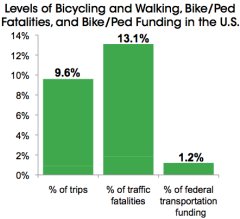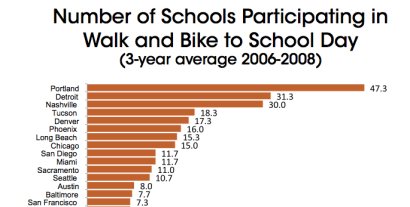
On the same day President Obama announced $8 billion for high speed rail and “the largest investment in infrastructure since the Interstate Highway System,” a report released today by the non-profit Alliance for Biking and Walking (formerly known as the Thunderhead Alliance) shows that in almost every state and major U.S. city people that walk and bike are at a disproportionate risk of being killed and are more likely to have serious health issues because they receive less than their fair share of transportation dollars.
I know you’re thinking, “Duh, we already knew that!” — but in this country, where biking and walking are still struggling to gain respect as viable modes of transportation, these sort of reports are needed to pressure lawmakers into action and to give advocates and citizens ammunition to push for change.
“State investment choices can be a life or death issue for people who walk and bike.”
— Jeff Miller, President of The Alliance for Biking and Walking
Bicycling and Walking in the United States: The 2010 Benchmarking Report (funded by the Centers for Disease Control, Bikes Belong Coaltion, and Planet Bike) finds that while biking and walking make up 10% of trips in the U.S. and people not in motor vehicles make up 13% of traffic fatalities, they receive less than 2% of federal transportation dollars.
This report should provide much-needed urgency to planners and city officials to improve and build more active transportation infrastructure. Now. Or, as Alliance president Jeff Miller puts it, “State investment choices can be a life or death issue for people who walk and bike.”
The report also reveals that in addition more to more people dying, places with inadequate non-motorized transportation infrastructure have, on average, the highest rates of obesity, diabetes, and high blood pressure. Not surprisingly, states with the highest levels of walking and biking have the lowest rates of those serious health issues.

The Alliance has also ranked the 51 largest U.S. cities in biking and walking levels, safety, funding, advocacy, and policies.
How’d Portland and Oregon do?
- Portland had more schools participate in National Walk and Bike to School Day than any other major U.S. city (47.3 schools on a 3-yr average).
- Portland ranked 9th in overall level of biking and walking. Oregon ranked 5th.
- Portland ranked 18th in per capita walk/bike spending. Oregon ranked 28th.
- Portland ranked 1st in cycling to work and 14th in walking to work.
- Portland ranked 7th in biking safety. Oregon ranked 10th.
- Portland ranked 14th in walking safety. Oregon ranked 20th.
This report also compared city staff levels devoted to biking and walking and includes an impressive amount of reference information on advocacy resources and bike policy and program comparisons for major U.S. cities. Read more and download the full report at PeoplePoweredMovement.org/benchmarking.

